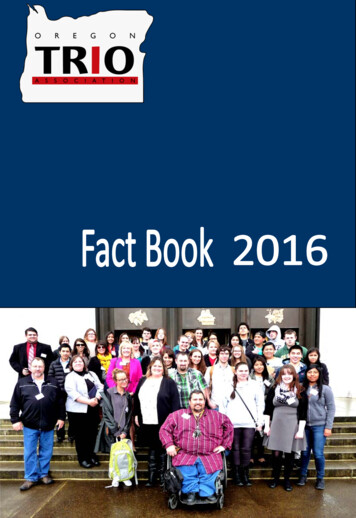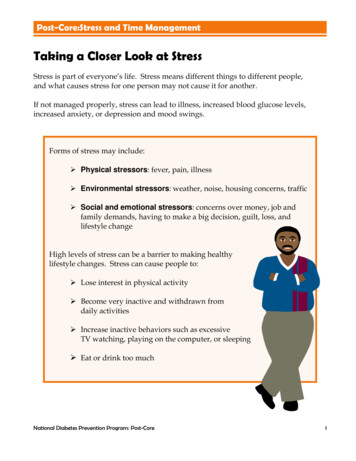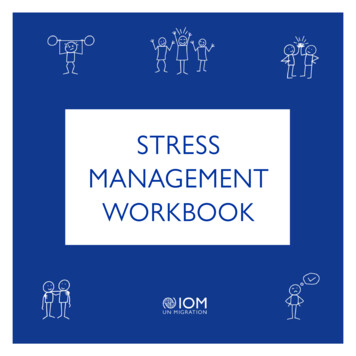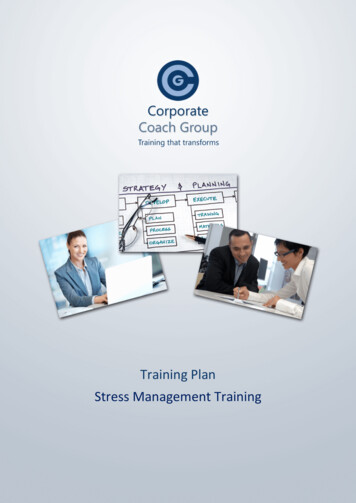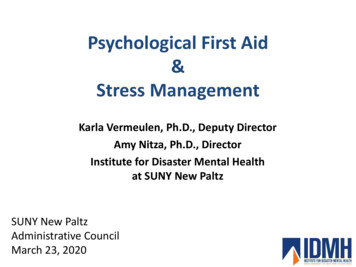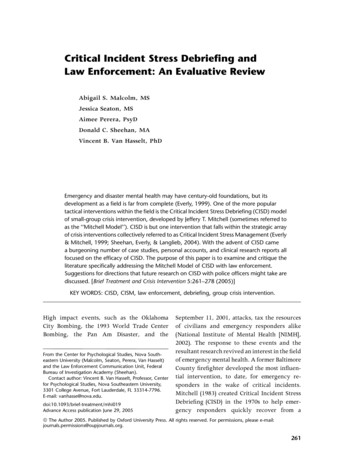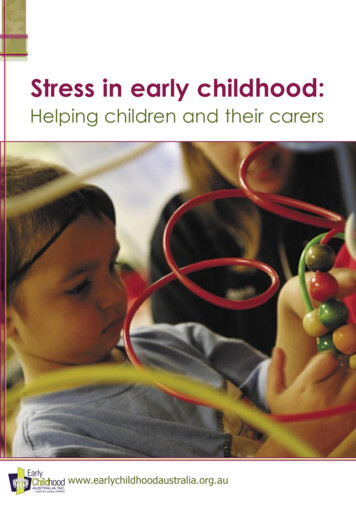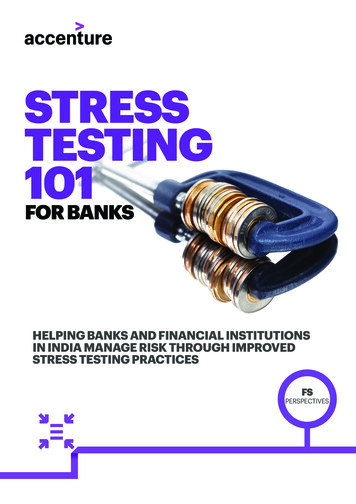
Transcription
NEPS WORKING PAPERSChristiane Gross and Katharina SeebaßTHE STANDARD STRESS SCALE (SSS):MEASURING STRESS IN THE LIFECOURSENEPS Working Paper No. 45Bamberg, June 2014
Working Papers of the German National Educational Panel Study (NEPS)at the Leibniz Institute for Educational Trajectories (LIfBi) at the University of BambergThe NEPS Working Papers publish articles, expertises, and findings related to the GermanNational Educational Panel Study (NEPS).The NEPS Working Papers are edited by a board of researchers representing the wide rangeof disciplines covered by NEPS. The series started in 2011.Papers appear in this series as work in progress and may also appear elsewhere. They oftenrepresent preliminary studies and are circulated to encourage discussion. Citation of such apaper should account for its provisional character.Any opinions expressed in this series are those of the author(s) and not those of the NEPSConsortium.The NEPS Working Papers are available kationen/nepsworkingpapersEditorial Board:Jutta Allmendinger, WZB BerlinCordula Artelt, University of BambergJürgen Baumert, MPIB BerlinHans-Peter Blossfeld, EUI FlorenceWilfried Bos, University of DortmundEdith Braun, DZHW HannoverClaus H. Carstensen, University of BambergHenriette Engelhardt-Wölfler, University of BambergFrank Kalter, University of MannheimCorinna Kleinert, IAB NürnbergEckhard Klieme, DIPF FrankfurtCornelia Kristen, University of BambergWolfgang Ludwig-Mayerhofer, University of SiegenThomas Martens, DIPF FrankfurtManfred Prenzel, TU MunichSusanne Rässler, University of BambergMarc Rittberger, DIPF FrankfurtHans-Günther Roßbach, LIfBiHildegard Schaeper, DZHW HannoverThorsten Schneider, University of LeipzigHeike Solga, WZB BerlinPetra Stanat, IQB BerlinVolker Stocké, University of KasselOlaf Struck, University of BambergUlrich Trautwein, University of TübingenJutta von Maurice, LIfBiSabine Weinert, University of BambergContact: German National Educational Panel Study (NEPS) – Leibniz Institute for EducationalTrajectories – Wilhelmsplatz 3 – 96047 Bamberg Germany contact@lifbi.de
The Standard Stress Scale (SSS):Measuring Stress in the Life CourseChristiane Gross, University of KonstanzKatharina Seebaß, Friedrich-Alexander-Universität Erlangen-NürnbergE-mail address of lead ic data:Gross, C. & Seebaß, K., (2014). The Standard Stress Scale (SSS): Measuring Stress in the LifeCourse (NEPS Working Paper No. 45). Bamberg: Leibniz Institute for Educational Trajectories,National Educational Panel Study.NEPS Working Paper No. 45, 2014
Gross, SeebaßThe Standard Stress Scale (SSS): Measuring Stress in theLife CourseAbstractThis contribution presents the Standard Stress Scale (SSS); this is a new scale which has beenspecially developed to meet the requirements of multicohort panel studies, such as theNational Educational Panel Study (NEPS), which refer to the whole life course. Accordingly,the SSS is consistently applicable for different age groups from 14 years old onwards and isalso suitable for a wide range of people irrespective of their stage in life and employmentsituation; the items are applicable for old-age pensioners, unemployed, employed and selfemployed, househusbands and –wives, for university students and so forth. To obtain thefinal 11-item Standard Stress Scale (SSS), 35 questions regarding stressful life situations,social stress, daily distress, anxieties about the future and other stresses and strains weredeveloped following the theoretical approach of the effort-reward imbalance model (ERI)and the demand-control model. These 35 items were pretested with different subsamples—such as students in different school types, university students, and adults in different lifestages—using self-administered questionnaires. The total sample of the pretest includes 372respondents. All of the 35 original questions had a small item-nonresponse rate and a goodvariance among respondents. Using factor analyses, the questions with the highest factorloading on each of the dimensions were used to represent the final 11-item SSS. In somecases, when the questions with the highest loading did not perform well in the cognitivepretest, the item with the second highest loading was chosen instead. Although the mostdistinct items were selected, the final 11 items of the SSS show good reliability values. For allsubsamples, the Cronbach's Alpha values vary in a range from 0.58 for the unemployed to0.66 for students. In addition to this, further analyses show a high correlation of the final SSSwith self-rated health.KeywordsStress, distress, scale, indexNEPS Working Paper No. 45, 2014Page 2
Gross, Seebaß1. IntroductionStress is one of the main determinants of health status (Backé, Seidler, Latza, Rossnagel, &Schumann, 2012; Steptoe, 1991); therefore an instrument to adequately measure stress is ofprime interest not only in public health research but also for the examination of educationalreturns. School and workplace requirements are both essential sources of stress, and stresslevels can also be affected by unemployment.To provide excellent data on nonmonetary returns to education—such as health—is onefocus of Pillar 5 (Returns to Education Over the Life Course) of the National EducationalPanel Study (NEPS). NEPS aims to use a constant scale, which meets the standards of surveymethodology, to measure stress for different age groups and living conditions. As none ofthe existing scales meets these requirements, we have developed the Standard Stress Scale(SSS) which is applied by NEPS but can also be used in further surveys. The SSS is applicablefor different age groups (14 years and above) and is also suitable for all sorts of peopleirrespective of their stage in life and employment situation. The SSS will be applied in theNEPS Starting Cohort 3—Grade 5 (in Grade 8), Starting Cohort 4—Grade 9, StartingCohort 5—First-Year Students, and Starting Cohort 6—Adults.We first present previous stress scales to underline the need for development of a newinstrument to measure stress in the life course (Section 2). Then we outline the theoreticaldimensions of stress on which the Standard Stress Scale is based (Section 3), introduce themethods used to develop the scale (Section 4) and also the results of the cognitive pretestand factor analyses along with an explanation of how to build a stress index (Section 5).Finally we show some attributes of the resulting stress index based on the SSS (Section 6).2. Previous Stress ScalesA variety of previous instruments to measure stress, available in a German version, aresummarized in Table 1.(a) Possibly the most popular instrument is the “Effort-Reward Imbalance Scale (ERI)”(Siegrist, 1996; Siegrist, Starke, Chandola, Godin, Marmot, Niedhammer, & Peter, 2004),which is based on the theoretical concept of reciprocity. The model of effort-rewardassumes that negative emotions occur when the effort made by a person is much higherthan the reward the person receives, meaning that the main principle of reciprocity hasbeen violated. Although the original scale was established to measure stress in theworkplace only, Siegrist and colleagues developed further scales addressed to school (Li,Shang, Wang, & Siegrist, 2010) and university students (in preparation). The strength ofthe ERI-Scale—being well adapted for specific life circumstances such as being anemployee or student—is a vital handicap for the application in multicohort panel studiesbut also for general cross-sectional surveys. There is no scale dedicated to unemployed,self-employed, pensioners or househusbands and -wives. Apart from that no version ofan ERI-scale is applicable from school age through to old age.(b) The second stress scale—“Skala sozialer Stressoren am Arbeitsplatz” (Frese & Zapf,1987)—is also limited to measuring stress in the workplace and in particular problems inin teams in the workplace.NEPS Working Paper No. 45, 2014Page 3
Gross, Seebaß(c) “The Social Readjustment Rating Scale (SRRS)” provided by Holmes and Rahe (1967)focuses on the number and impact of life change events and is not limited to employees.But the SRRS is a product of its time containing items such as “wife begin or stop work”,which are addressed to heterosexual men only.(d) The “Stress-Reaktivitäts-Skala (SRS)” by Schulz, Jansen, and Schlotz (2005) is applicablefor adult populations only and is mainly used in clinical research to evaluate copingstrategies used for stressful situations.The last two scales are for universal use:(e) The “Trierer Inventar zur Erfassung von chronischem Stress (TICS)” by Schulz, Schlotz,and Becker (2004) covers six dimensions of chronic stress: excess of work, dissatisfactionwith work, social strains, lack of social approval, anxiety and incriminatory memories.Although the issue “work” is very present here the items could be used for othersubgroups too when interpreting “work” in a wider sense. Nevertheless, the scale doesnot meet standards of survey methodology as it has items with two dimensions.(f) The “Perceived Stress Questionnaire (PSQ)” by Levenstein, Prantera, Varvo, Scribano,Berto, Luzi, and Andreoli (1993) is also available in a German version (Fliege, Rose, Arck,Levenstein, & Klapp, 2001; Fliege, Rose, Arck, Walter, Kocalevent, Weber,& Klapp, 2005).It focuses on stress as a result of perceived strains. The German version has beenvalidated with a sample of women after giving birth or having had a miscarriage, and asample of students of medicine (Fliege et al., 2001), and also in a general householdsurvey (Kocalevent, Hinz, Brähler, & Klapp, 2011). To date there is no validation orcognitive pretest for school-aged children. In addition 30 items are a lot for a largesurvey.As previous scales do not meet the acquirements of NEPS (a constant scale for many cohortsand all life situations of adults with a small number of items covering many dimensions ofstress and having no methodological flaws) we developed the Standard Stress Scale (SSS) foruse in NEPS and other general surveys.NEPS Working Paper No. 45, 2014Page 4
Table 1Previous Stress ScalesScaleTheoretical focus/dimensions of stressTargetpopulation#Items 1ReferencesComments(a) Effort-rewardimbalance scale(ERI)Imbalance of effort and rewardEmployees,(university)students23Siegrist (1996),Siegrist et al.(2004)Suitable for surveys with specialgroups, no constant scale for allsubgroups, lack of instruments forspecial subgroups such as unemployed(b) Skala sozialerStressoren amArbeitsplatzSocial stress in the workplaceEmployees17 (8)Frese and Zapf(1987)Suitable for measuring employees stress levels, especially socialproblems in teams in the workplace(c) The SocialReadjustmentRating Scale (SRRS)Number and severity of life changeeventsAdults43Holmes and Rahe(1967)For (male) adults only, obsolete itemsaddressed to heterosexual men suchas “wife begin or stop work”(d) StressReaktivitäts-Skala(SRS)Stress reactivity, individual copingstrategies, “the extent to which aperson is likely to show emotional orphysical reactions to a stressful event”(Bolger & Zuckerman 1995: 890)Adults29Schulz et al. (2005)For adults only, focus on clinicalresearch(e) Trierer Inventarzur Erfassung vonchronischem Stress(TICS)Six dimensions of chronic stress: excessof work, dissatisfaction with work,social strains, lack of social approval,anxiety and incriminatory memoriesUniversal57 (12)Schulz et al. (2004)Items with two dimensions do notmeet standards of surveymethodology(f) Perceived StressQuestionnaire(PSQ)Stress as representation of perceivedstrainsUniversal30Levenstein et al.(1993); Fliege et al.2001, 2005No validation for school-aged children,no short version available1Number of items in short version in parenthesis.NEPS Working Paper No. 45, 2014Page 5
3. Dimension of Stre
Six dimensions of chronic stress: excess of work, dissatisfaction with work, social strains, lack of social approval, anxiety and incriminatory memories Universal 57 (12) Schulz et al. (2004) Items with two dimensions do not meet standards of survey methodology (f) Perceived Stress Questionnaire (PSQ) Stress as representation of perceived


